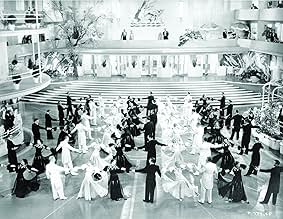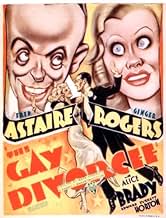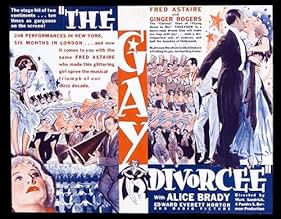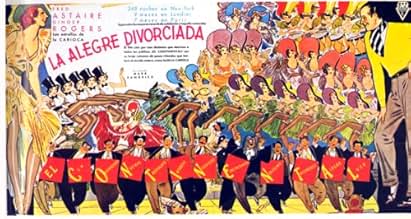VALUTAZIONE IMDb
7,3/10
9046
LA TUA VALUTAZIONE
Aggiungi una trama nella tua linguaA woman thinks a flirting man is the co-respondent her lawyer has hired to expedite her divorce.A woman thinks a flirting man is the co-respondent her lawyer has hired to expedite her divorce.A woman thinks a flirting man is the co-respondent her lawyer has hired to expedite her divorce.
- Regia
- Sceneggiatura
- Star
- Vincitore di 1 Oscar
- 4 vittorie e 5 candidature totali
Norman Ainsley
- Undetermined Role
- (non citato nei titoli originali)
Jimmy Aubrey
- Undetermined Role
- (non citato nei titoli originali)
Finis Barton
- Undetermined Role
- (non citato nei titoli originali)
Eleanor Bayley
- Dancer
- (non citato nei titoli originali)
De Don Blunier
- Chorus Girl
- (non citato nei titoli originali)
Pokey Champion
- Dancer
- (non citato nei titoli originali)
Jack Chefe
- Night Club Patron
- (non citato nei titoli originali)
Recensioni in evidenza
Quoting the Eric Blore/Alice Brady interchange in the restaurant, this movie is indeed whimsical (or "whumsical") and beautiful to boot. There probably has never been a more perfect dance than "Night and Day"....or a more beautiful song to dance to. That is the highlight of this film, although the rest of it is well worth seeing. Erik Rhodes is absolutely hilarious as the paid correspondent and the humor is not dated which is unusual in a film of this age. The "Chance is a fool's name for fate" routine is priceless. Edward Everett Horton again proves that he is the originator of the befuddled sidekick without being irritating and his little "dance" with a very young Betty Grable is such fun The art deco sets and great 30's clothes are wonderful and it makes you wish for a time when everybody wore evening dress and danced at the drop of a hat. Don't miss it...this is one of the highlight Astaire/Rogers efforts.
Looking at THE GAY DIVORCEE through the lens of 85 years, I can see flaws with it. The big dance number goes on too long, and the comedy writing isn't sharp enough. Still, this was the first star pairing of Fred Astaire and Ginger Rogers, and it's amazing how much they got right, right off the bat. There's the basic structure of Astaire courting Miss Rogers through a set of dances, while in between there are jokes and pulled faces and Edward Everett Horton doing several hundred double takes per minute as everyone's straight man.
It's based on Astaire's stage success The Gay Divorce. The name change was the result of the Breen office meddling. It's more a variation on the Princess Theater musical comedies of the 1920s, and the camerawork, although seemingly startling and original under the direction of David Abel, is more an outgrowth of German Expressionist camerawork, and bits and bobs from the best of contemporary British musicals. Add in Astaire's insistence on being seen full length while dancing -- which sounds obvious now, although not at the time -- and the formula required only a bit of refinement to produce a series of masterpieces.
You may notice Betty Grable at the bottom of the title card. She's the platinum blonde who makes love to Horton in the "Let's Knock Knees" number. She had been kicking around Hollywood since 1929, sometimes with a credit, sometimes, like her previous movie, without. She would never go uncredited again.
It's based on Astaire's stage success The Gay Divorce. The name change was the result of the Breen office meddling. It's more a variation on the Princess Theater musical comedies of the 1920s, and the camerawork, although seemingly startling and original under the direction of David Abel, is more an outgrowth of German Expressionist camerawork, and bits and bobs from the best of contemporary British musicals. Add in Astaire's insistence on being seen full length while dancing -- which sounds obvious now, although not at the time -- and the formula required only a bit of refinement to produce a series of masterpieces.
You may notice Betty Grable at the bottom of the title card. She's the platinum blonde who makes love to Horton in the "Let's Knock Knees" number. She had been kicking around Hollywood since 1929, sometimes with a credit, sometimes, like her previous movie, without. She would never go uncredited again.
Fred and Ginger, two perfect partners, two of the best dancers in history. In 1934, the toast of RKO. What a great pair the studio that would become defunct in a matter of years had on their hands!
In 1933, the pair had proven themselves as second leads in "Flying Down to Rio", a musical heavily relying on special effects and little else. They stole the show, proven with "The Carioca", the erotically charged dance number which started an American craze of pressing foreheads and even got the Best Song Oscar nod over the supposed show stopping title song. Before, Ginger had "42nd Street" to her name, while Fred had the famous screen test analysis of "Can't sing. Can't act. Can dance a little."
"The Gay Divorcee" is the establishing musical of Astaire and Rogers. Silly, dated, slight, even stupid to a certain degree is the entire story. Without a doubt, high comedy and immense creativity make up for it. The mistaken identity plot was recycled for "Top Hat" the following year, but it hardly matters. It is littered entirely with hilarity! Writing was never the strongest point of these musicals anyway. The performances were not Oscar calibre but they were publicly loved, and it's obviously Astaire and Roger's singing, acting and most of all, dancing, that makes the movie what it is.
A top wealth of talent was assembled for the movie. Erik Rhodes is absolutely side splitting as the Italian guy Tonetti, wielding the fabulous line, "Your wife is safe with Tonetti, he prefers spaghetti!". Alice Brady is there as Aunt Hortense, but Edward Everett Horton is another stand out performer as the lawyer. His fumbling voice provides a character of clumsiness and two seem to go hand in hand. He was definitely one of the best supporting comedians of the 1930s and 1940s, in other Astaire and Rogers musicals, and movies like "Lost Horizon", "Holiday", "Here Comes Mr Jordan" and "Arsenic and Old Lace".
Only one song was retained for the filmic version of "The Gay Divorcee". The censors even crashed down on the stage's original title "The Gay Divorce". Fred performs a great rendition of the immortal Cole Porter song "Night and Day". "The Continental", the Best Song of 1934 is thrown there in the mix too. Other great numbers in there include "Looking for a needle in a haystack", "Don't Let it Bother You" and "Let's K-nock- K-nees". The latter is performed by a young Betty Grable. This is notable for the only time Edward Everett Horton sings and dances on screen. We can see from the results there's an obvious reason.
The stylish period of courtship and even set decoration and costumes evoke great memories of eras gone by. RKO hasn't helped preservation of these technical elements by throwing what always appears to be mediocre sets, but it doesn't matter anyway. The whole thing is irresistible, spectacular and unforgettable. This is one of the forgotten musicals of the time which has it all.
Rating: 8/10
In 1933, the pair had proven themselves as second leads in "Flying Down to Rio", a musical heavily relying on special effects and little else. They stole the show, proven with "The Carioca", the erotically charged dance number which started an American craze of pressing foreheads and even got the Best Song Oscar nod over the supposed show stopping title song. Before, Ginger had "42nd Street" to her name, while Fred had the famous screen test analysis of "Can't sing. Can't act. Can dance a little."
"The Gay Divorcee" is the establishing musical of Astaire and Rogers. Silly, dated, slight, even stupid to a certain degree is the entire story. Without a doubt, high comedy and immense creativity make up for it. The mistaken identity plot was recycled for "Top Hat" the following year, but it hardly matters. It is littered entirely with hilarity! Writing was never the strongest point of these musicals anyway. The performances were not Oscar calibre but they were publicly loved, and it's obviously Astaire and Roger's singing, acting and most of all, dancing, that makes the movie what it is.
A top wealth of talent was assembled for the movie. Erik Rhodes is absolutely side splitting as the Italian guy Tonetti, wielding the fabulous line, "Your wife is safe with Tonetti, he prefers spaghetti!". Alice Brady is there as Aunt Hortense, but Edward Everett Horton is another stand out performer as the lawyer. His fumbling voice provides a character of clumsiness and two seem to go hand in hand. He was definitely one of the best supporting comedians of the 1930s and 1940s, in other Astaire and Rogers musicals, and movies like "Lost Horizon", "Holiday", "Here Comes Mr Jordan" and "Arsenic and Old Lace".
Only one song was retained for the filmic version of "The Gay Divorcee". The censors even crashed down on the stage's original title "The Gay Divorce". Fred performs a great rendition of the immortal Cole Porter song "Night and Day". "The Continental", the Best Song of 1934 is thrown there in the mix too. Other great numbers in there include "Looking for a needle in a haystack", "Don't Let it Bother You" and "Let's K-nock- K-nees". The latter is performed by a young Betty Grable. This is notable for the only time Edward Everett Horton sings and dances on screen. We can see from the results there's an obvious reason.
The stylish period of courtship and even set decoration and costumes evoke great memories of eras gone by. RKO hasn't helped preservation of these technical elements by throwing what always appears to be mediocre sets, but it doesn't matter anyway. The whole thing is irresistible, spectacular and unforgettable. This is one of the forgotten musicals of the time which has it all.
Rating: 8/10
After their hit dancing of the "Carioca" in "Flying Down the Rio," RKO gave the teaming of Fred Astaire and Ginger Rogers a star role in "The Gay Divorcée" in 1934.
With few exceptions, the plots of the Fred-Ginger films were excuses to get to the important part - the dancing - but the story lines were always pleasant and the casting good.
"The Gay Divorcée" was based on a Broadway musical (of which the only number retained is "Night and Day") and it appears that a few of its plot devices were adopted in later Astaire-Rogers films as well.
One such plot device is that of mistaken identity. In this movie, Astaire (reprising his Broadway role) is mistaken for a professional correspondent hired to help Rogers get her divorce. Another device is that at first, Ginger is never interested in Fred - that goes here, too.
And there's a stock cast in these films, namely, Edward Everett Horton and Eric Blore (and of course, he's always the butler and always very funny). Horton plays Rogers' attorney whose major problem is Rogers' aunt (Alice Brady).
What can be said about the dancing except that it's glorious? Fred and Ginger dance to "Night and Day" after Astaire sings it to her. For a supposed non-singer, Astaire could really put over a song - his voice is pleasant and he's so musical - no wonder composers wrote songs for him.
Ginger is beautiful and spunky as Mimi, a young woman ducking Fred while she's trying to get a divorce. Betty Grable has a bit that showcases her in the number "Let's K-knock Kneez." There's also "I'm Looking for a Needle in a Haystack" delightfully sung and danced by Fred. Astaire's dancing is fantastic throughout.
It feels as if about half the picture is taken up with the elaborately staged production number, "The Continental." In later films, of course, the dancing would center more around Fred and Ginger, but it's a great part of the movie and certainly solidified these two as a top box office pairing.
For pure enjoyment, there's nothing like watching Astaire & Rogers in these movies.
With few exceptions, the plots of the Fred-Ginger films were excuses to get to the important part - the dancing - but the story lines were always pleasant and the casting good.
"The Gay Divorcée" was based on a Broadway musical (of which the only number retained is "Night and Day") and it appears that a few of its plot devices were adopted in later Astaire-Rogers films as well.
One such plot device is that of mistaken identity. In this movie, Astaire (reprising his Broadway role) is mistaken for a professional correspondent hired to help Rogers get her divorce. Another device is that at first, Ginger is never interested in Fred - that goes here, too.
And there's a stock cast in these films, namely, Edward Everett Horton and Eric Blore (and of course, he's always the butler and always very funny). Horton plays Rogers' attorney whose major problem is Rogers' aunt (Alice Brady).
What can be said about the dancing except that it's glorious? Fred and Ginger dance to "Night and Day" after Astaire sings it to her. For a supposed non-singer, Astaire could really put over a song - his voice is pleasant and he's so musical - no wonder composers wrote songs for him.
Ginger is beautiful and spunky as Mimi, a young woman ducking Fred while she's trying to get a divorce. Betty Grable has a bit that showcases her in the number "Let's K-knock Kneez." There's also "I'm Looking for a Needle in a Haystack" delightfully sung and danced by Fred. Astaire's dancing is fantastic throughout.
It feels as if about half the picture is taken up with the elaborately staged production number, "The Continental." In later films, of course, the dancing would center more around Fred and Ginger, but it's a great part of the movie and certainly solidified these two as a top box office pairing.
For pure enjoyment, there's nothing like watching Astaire & Rogers in these movies.
The Gay Divorcée is the answer to the trivia question of which of Fred Astaire's and Ginger Rogers's is one that Fred Astaire had previously done on Broadway. When Astaire did it on Broadway, the Cole Porter musical had been entitled The Gay Divorce. But that extra 'e' was added on lest anyone get the idea that divorce itself was something frivolous. Imagine anticipating Britney Spears by about 70 years.
Actually Fred had also done Funny Face and The Bandwagon on stage as well. But on stage The Bandwagon was a revue and Funny Face had an entirely different plot than the musical made by Astaire in the Fifties. Only in The Gay Divorcée was he asked to repeat a stage role.
The basic plot is still the same, the usual Astaire-Rogers case of mistaken identity. Ginger is the budding divorcée going to London to get a divorce as Aunt Alice Brady hired a professional co-respondent. Ginger mistakes Fred for that co-respondent and it takes a while for Fred to warm her up.
Fred's an American musical comedy star visiting London with his manager Edward Everett Horton who also happens to know Brady. This gives the excuse for the musical numbers.
Cole Porter's score was cut completely from the screen other than the immortal Night and Day. In it's place came four songs, three written by Harry Revel&Mack Gordon and one written by Con Conrad&Herb Magdison. Fred and Ginger dance divinely to Night and Day.
Fred does a solo dance to A Needle in a Haystack and Don't Let It Bother You. Betty Grable got her first notice from the movie going public, singing and dancing in Let's Knock Knees all of which were contributed by Revel&Gordon.
But it was The Continental number by Con Conrad and Herbert Magdison that got the first Academy Award ever given out for Best Original Song in a motion picture. It's what The Gay Divorcée is remembered for today. It's a rather long, between ten and fifteen minutes of screen time, but as magical as ever
The Gay Divorce ran for 248 performances on Broadway during the 1932- 1933 season. Sacrificed for romance are Porter's witty lyrics in the rest of the score containing their usual commentary on the social scene. Of all the American musical giants of the era, I would say that Cole Porter wins hands down as the man that Hollywood butchered the most in bringing his work to the screen. Even before The Code was in place, it seemed that the powers that be deemed that his work was way too sophisticated and naughty to be seen and heard as is.
Still with the film being frothy romance instead of social commentary, The Gay Divorcée is still great entertainment. Also repeating their roles from Broadway are supercilious waiter Eric Blore and the real co-respondent Tonetti who prefers spaghetti, Erik Rhodes.
Wit for romance, you decide if it was a fair exchange.
Actually Fred had also done Funny Face and The Bandwagon on stage as well. But on stage The Bandwagon was a revue and Funny Face had an entirely different plot than the musical made by Astaire in the Fifties. Only in The Gay Divorcée was he asked to repeat a stage role.
The basic plot is still the same, the usual Astaire-Rogers case of mistaken identity. Ginger is the budding divorcée going to London to get a divorce as Aunt Alice Brady hired a professional co-respondent. Ginger mistakes Fred for that co-respondent and it takes a while for Fred to warm her up.
Fred's an American musical comedy star visiting London with his manager Edward Everett Horton who also happens to know Brady. This gives the excuse for the musical numbers.
Cole Porter's score was cut completely from the screen other than the immortal Night and Day. In it's place came four songs, three written by Harry Revel&Mack Gordon and one written by Con Conrad&Herb Magdison. Fred and Ginger dance divinely to Night and Day.
Fred does a solo dance to A Needle in a Haystack and Don't Let It Bother You. Betty Grable got her first notice from the movie going public, singing and dancing in Let's Knock Knees all of which were contributed by Revel&Gordon.
But it was The Continental number by Con Conrad and Herbert Magdison that got the first Academy Award ever given out for Best Original Song in a motion picture. It's what The Gay Divorcée is remembered for today. It's a rather long, between ten and fifteen minutes of screen time, but as magical as ever
The Gay Divorce ran for 248 performances on Broadway during the 1932- 1933 season. Sacrificed for romance are Porter's witty lyrics in the rest of the score containing their usual commentary on the social scene. Of all the American musical giants of the era, I would say that Cole Porter wins hands down as the man that Hollywood butchered the most in bringing his work to the screen. Even before The Code was in place, it seemed that the powers that be deemed that his work was way too sophisticated and naughty to be seen and heard as is.
Still with the film being frothy romance instead of social commentary, The Gay Divorcée is still great entertainment. Also repeating their roles from Broadway are supercilious waiter Eric Blore and the real co-respondent Tonetti who prefers spaghetti, Erik Rhodes.
Wit for romance, you decide if it was a fair exchange.
Trama
Lo sapevi?
- QuizThe musical number "The Continental" lasts 17 1/2 minutes, the longest number ever in a musical until Gene Kelly's 18 1/2-minute ballet at the end of Un americano a Parigi (1951) 17 years later. It is also the longest musical number in all of Fred Astaire and Ginger Rogers' films together.
- BlooperDuring the car chase, Guy makes a quick turn on a dirt road, and a sound effect of squealing tires is heard. Tires do not make a squealing noise on dirt.
- Citazioni
Tonetti: [unable to remember his passphrase "Chance is a fool's name for fate," Tonettie repeatedly muffs it] Chance is the foolish name for fate. / Give me a name for chance and I am a fool. / Fate is a foolish thing to take chances with. / I am a fate to take foolish chances with. / Chances are that fate is foolish. / Fate is the foolish thing. Take a chance.
- Versioni alternativeIn the version of the movie released in Brazil in the 1930s, the Brazilian actor Raul Roulien sang in the musical number "The Continental".
- ConnessioniEdited into L'ora del destino (1942)
- Colonne sonoreDon't Let It Bother You
(1934)
Music and Lyrics by Mack Gordon and Harry Revel
Dance performed by Fred Astaire
I più visti
Accedi per valutare e creare un elenco di titoli salvati per ottenere consigli personalizzati
- How long is The Gay Divorcee?Powered by Alexa
Dettagli
- Data di uscita
- Paese di origine
- Sito ufficiale
- Lingue
- Celebre anche come
- La alegre divorciada
- Luoghi delle riprese
- Santa Monica, California, Stati Uniti(Exterior)
- Azienda produttrice
- Vedi altri crediti dell’azienda su IMDbPro
Botteghino
- Budget
- 520.000 USD (previsto)
- Lordo in tutto il mondo
- 6879 USD
- Tempo di esecuzione1 ora 47 minuti
- Colore
- Proporzioni
- 1.37 : 1
Contribuisci a questa pagina
Suggerisci una modifica o aggiungi i contenuti mancanti

Divario superiore
By what name was Cerco il mio amore (1934) officially released in India in English?
Rispondi
































